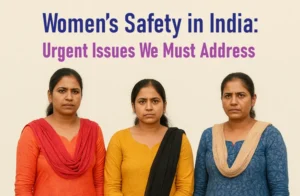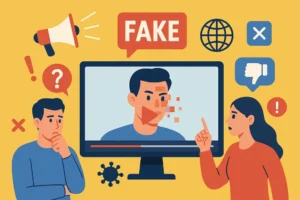The Role of Education in Promoting Gender Equality: Successful Global Initiatives
Gender equality means equal rights, responsibilities, and opportunities for all genders. It is a fundamental human right and a key component of sustainable development.
Education plays a powerful role in achieving gender equality. It helps individuals challenge traditional gender roles, increases economic opportunities, and fosters inclusive societies.
In this article, we will explore the role of education in promoting gender equality and addressing discrimination, violence, and other forms of inequality based on gender. We also discuss successful global initiatives to address gender inequality in education. So, read this article to the end!

Introduction: How Education Drives Gender Equality
Gender equality is the principle that all people—regardless of gender—should have equal rights, responsibilities, and opportunities. It is a cornerstone of social justice and a critical factor for sustainable development.
As of 2023, Unicef reports that 129 million girls are out of school globally. This includes 32 million of primary school age and 97 million of secondary school age.
In low-income countries, only 66% of girls complete primary school, compared to 73% of boys.
In sub-Saharan Africa, 9 million girls aged 6-11 will never go to school, compared to 6 million boys.
In South Asia, adolescent girls are 50% more likely than boys to be out of secondary school.
In conflict zones, girls’ enrolment drops by 2% on average, while boys’ drops by 1%. These gaps widen under poverty and instability.
Education is one of the most powerful tools to advance gender equality. Education provides quality learning opportunities for all and helps break down stereotypes, promote economic growth, reduce poverty, and foster healthier communities.
Education shapes modern societies by empowering individuals and dismantling systemic inequalities. By investing in education, nations build a foundation for fairness, opportunity, and sustainable development.
According to UNICEF, educated mothers are more likely to send their children to school, improving the education cycle across generations.
Educated women are more likely to vote and run for public office. Countries with high female literacy rates often have more women in parliament.
A 2020 report from the Inter-Parliamentary Union showed that nations with gender-equal education policies have a higher representation of women in leadership.
Why Gender Equality Matters
Gender equality benefits society as a whole. When women and men share power and resources equally, economies grow faster, health improves, and social stability increases.
According to the World Bank, closing the gender gap in education and labor force participation could raise global GDP by up to USD 28 trillion by 2025.
Countries like Sri Lanka and Vietnam have seen increased female labor participation after investing in girls’ education.
Girls with secondary education are six times less likely to marry as children, reducing population pressure and improving maternal health.
Equal access to education also improves children’s survival rates, lowers maternal mortality, and reduces the risk of child marriage.
As Sustainable Development Goal 5 emphasizes, achieving gender equality is essential for building peaceful, prosperous societies.
How Education Empowers Individuals
Education equips individuals with knowledge, skills, and confidence. For girls, it delays marriage, reduces teenage pregnancy, and improves health outcomes.
- Delayed marriage: Each additional year of secondary education reduces the likelihood of child marriage by 5 percentage points. Girls who complete secondary school are six times less likely to marry as children than those with no education.
- Health benefits: Educated women are more likely to understand family planning, leading to lower fertility rates and healthier mothers. Maternal mortality drops by 7–9% for each extra year of maternal education.
- Economic empowerment: According to UNESCO, each extra year of schooling can increase a woman’s earnings by 10–20%. Educated women participate more in the labor force and earn higher wages.
The Link Between Education and Gender Equality
Education is one of the most powerful tools to combat gender inequality. It empowers girls and boys to make informed choices, reduces child marriage, and promotes participation in economic and political life.
Education increases women’s economic participation by equipping them with valuable skills and credentials. This opens employment opportunities and raises household incomes, fueling national economic growth. By reducing skill gaps and fostering workforce diversity, education drives higher productivity and fairer resource distribution within societies.
Access to education improves health literacy among girls and women, enabling informed decisions about nutrition, hygiene, and family planning. Educated mothers are more likely to seek medical care, resulting in lower child and maternal mortality rates. Education thus enhances public health outcomes for entire communities.
Education challenges social norms by exposing learners to diverse perspectives and gender-equitable values. Schools foster critical thinking that questions stereotypes and discriminatory practices. As educated individuals advocate for equal rights, community attitudes evolve, leading to deeper cultural shifts toward gender equality.
Literacy and learning empower women politically, increasing civic engagement and leadership. Educated women are more likely to vote, participate in public debates, and run for office. This leads to more representative governance and policies that reflect women’s priorities and needs.
Education breaks intergenerational cycles of inequality by raising daughters of educated mothers are more likely to attend school themselves. This creates a virtuous cycle: each educated generation invests more in the next, amplifying social and economic benefits across decades.
Education fosters innovation by including women in research, technology, and entrepreneurship. Diverse teams generate broader ideas and solutions, enhancing competitiveness. When girls access STEM subjects early, they contribute to scientific advancements and drive inclusive economic development.
Barriers to Gender Equality in Education
Despite progress, many barriers still prevent girls and women from accessing quality education:
- Cultural norms and bias: Traditional views prioritize boys’ education over girls’. In some communities, families view girls as economic burdens and withdraw them from school to care for siblings or work.
- Safety and security: Fear of violence, harassment, or long commutes keeps many girls home. In Pakistan and Afghanistan, attacks on schools deepen gender gaps.
- Economic constraints: When families face poverty, they often invest in boys’ schooling, expecting girls to marry early or work domestically. School fees, uniforms, and books can be prohibitive.
- Inadequate facilities: Lack of separate sanitation facilities and menstrual hygiene products leads to high dropout among adolescent girls.
- Child marriage and early pregnancy: Girls married before 18 are 50% less likely to complete primary school and nearly 80% less likely to complete secondary school.
The Role of Teachers and Curriculum
Teachers and school curricula play a vital role in challenging gender norms. Schools are more than places of learning. They shape the attitudes and behaviors of young people. Teachers play a crucial role in promoting gender equality through:
Equitable classroom practices: Equitable classroom practices help ensure all students, regardless of gender, receive equal attention and opportunities. Inclusive questioning, seating arrangements, and leadership roles contribute to fairer participation and better student outcomes.
Gender-sensitive curricula: Gender-sensitive curricula remove outdated stereotypes and showcase successful women in science, leadership, and arts. When textbooks and lessons reflect diversity, students see what’s possible and reshape their career aspirations.
Professional training: Professional training equips teachers with the tools to recognize and address unconscious biases. Training in inclusive pedagogy improves interactions, reduces discrimination, and helps educators support students from different gender backgrounds effectively.
Mentorship programs: Mentorship programs provide role models who inspire confidence in girls. Female mentors in STEM, politics, or sports help girls set higher goals, face challenges, and stay engaged in school for longer periods.
Successful Global Initiatives to Address Gender Inequality in Education
There are several successful global initiatives aimed at addressing gender inequality in education. Here are a few notable ones:
UNESCO’s Gender Equality Strategy in Education
UNESCO’s 2019-2025 Gender Equality Strategy focuses on breaking barriers that prevent equal access to education. It aims to strengthen legal protections, improve curricula, and expand scholarships for marginalized genders. Initiatives like “Her Education, Our Future” support gender-responsive policies, ensuring all learners, especially girls, receive quality education without discrimination.
Global Education Coalition
Launched during the COVID-19 pandemic, the Global Education Coalition mobilized governments, NGOs, and private organizations to tackle learning disruptions, with gender equality at its core. It promotes gender-sensitive educational policies, provides learning resources, and addresses disparities. The coalition focuses on increasing access to digital tools, scholarships, and mentorship to support girls’ education globally.
UNICEF’s No Lost Generation Initiative
This initiative provides education and psychosocial support to children, especially girls, in conflict-affected areas. It ensures learning continuity during crises by offering safe spaces, digital learning tools, and mental health support. The program operates in regions impacted by war, such as Syria and Iraq, helping young learners rebuild their futures.
The Global Partnership for Education (GPE)
GPE provides funding to remove barriers to girls’ education, supports innovative learning solutions, and combats gender-based violence in schools. It collaborates with governments and organizations to improve education systems in developing countries, ensuring that all children, especially girls, receive quality education.
The World Bank’s Education for Competitiveness (E4C) Initiative
E4C enhances girls’ education through financial and technical assistance, focusing on skill development and employability. It aims to bridge educational gaps in the Middle East and North Africa, ensuring that young women gain access to quality learning and career opportunities.
UN Women’s Regional Programme
This program promotes girls’ rights and empowerment through community-based education initiatives. It focuses on creating inclusive learning environments, challenging stereotypes, and advocating for policies that support gender equality in education across various regions.
Global Platform for Gender Equality in and through Education
This platform mobilizes partners to disrupt cycles of low education and productivity. It fosters collaboration among governments, NGOs, and educators to advance gender equality in learning, ensuring that marginalized groups receive equitable opportunities.
UNESCO’s Gender Equality Action Plan
UNESCO’s plan advocates for gender-sensitive policies and training to promote inclusive education. It challenges harmful gender norms by integrating equality-focused curricula, supporting female leadership, and ensuring equitable access to learning resources. The initiative aligns with global efforts to empower women and girls through education.
GirlForce Initiative
UNICEF’s GirlForce Initiative emphasizes skills, education, and training for girls, equipping them with tools for success. It focuses on vocational training, leadership development, and digital literacy to empower young women and prepare them for the workforce.
UN Sustainable Development Goals (SDGs)
SDG 4 aims to ensure inclusive and equitable quality education for all, promoting lifelong learning opportunities regardless of gender. It aligns with global efforts to eliminate educational disparities and foster gender equality in learning environments.
International Day of the Girl
Observed annually on October 11, International Day of the Girl highlights challenges faced by girls worldwide, especially in education. It raises awareness about gender-based discrimination, encourages policymaking, and promotes girls’ leadership opportunities. Governments and advocacy groups use this occasion to push for reforms ensuring girls’ rights to education, health, and empowerment.
Legal Protections for Girls’ Education
Many countries have eliminated discriminatory policies restricting pregnant and parenting girls from attending school. Between 2019 and 2022, restrictive laws halved globally, increasing educational access for millions. Legal reforms now ensure girls remain in school without penalties, supporting their right to equal learning opportunities, protection from discrimination, and educational continuity.
Promoting Gender Equity in Education: Country-Wise Initiatives
Many countries have implemented initiatives to promote gender equity in education. Here are some notable examples:
1. India – Beti Bachao, Beti Padhao (Save the Girl Child, Educate the Girl Child)
Launched in 2015, this government campaign promotes the education and empowerment of girls. It addresses declining child sex ratios and improves access to education by raising awareness, strengthening enforcement of child rights, and offering incentives to families for educating daughters, especially in rural and underserved communities.
2. Pakistan – Waseela-e-Taleem (Education for All) Program
Implemented under the Benazir Income Support Programme, Waseela-e-Taleem provides conditional cash transfers to low-income families to send their children, especially girls, to school. The initiative tackles poverty-linked gender gaps in education and boosts primary school enrollment and attendance among girls across multiple provinces.
3. Bangladesh – Female Secondary School Assistance Project (FSSAP)
Supported by the World Bank, FSSAP has increased girls’ enrollment and retention in secondary schools by offering stipends, tuition waivers, and free textbooks. It targets rural girls and has significantly narrowed the gender gap in secondary education since its launch in the 1990s.
4. United States – Title IX of the Education Amendments (1972)
Title IX is a landmark U.S. law prohibiting gender-based discrimination in federally funded education programs. It has greatly increased female participation in academics and sports, promoted equality in STEM fields, and continues to be a powerful tool for addressing sexual harassment and gender bias in schools and universities.
5. United Kingdom – Girls’ Education Challenge (GEC)
Launched by the UK’s Foreign, Commonwealth & Development Office, the GEC funds programs in developing countries to support marginalized girls in completing quality education. It focuses on overcoming gender-related barriers, including early marriage and poverty, and has reached over a million girls worldwide since 2012.
6. Nigeria – Safe Schools Initiative
Introduced after the Chibok schoolgirl kidnappings, this initiative improves school safety and supports education for girls in conflict zones. Through partnerships with the Nigerian government and international donors, it rebuilds schools, provides psychosocial support, and promotes community awareness about girls’ education in northern Nigeria.
7. Afghanistan – Community-Based Education (CBE) Programs
In conflict-affected and remote areas, CBE initiatives offer local schooling options, especially for girls. Supported by NGOs and international donors, these programs overcome mobility and cultural barriers, bringing education to the doorstep and significantly boosting girls’ enrollment where formal schools are inaccessible.
8. Middle East – UNRWA Girls’ Education Program
The United Nations Relief and Works Agency (UNRWA) runs gender-inclusive education programs for Palestinian refugees across the Middle East. It promotes equal access to education, gender-sensitive curricula, and female leadership, achieving near gender parity in enrollment in its schools in Jordan, Lebanon, Gaza, and the West Bank.
9. Kenya – Free Primary Education (FPE) Policy
Introduced in 2003, FPE abolished primary school fees, improving access for girls from poor families. Combined with community sensitization and school feeding programs, the policy reduced gender disparities and helped increase national female literacy rates, especially in rural and marginalized areas.
10. Ethiopia – GEQIP-E (General Education Quality Improvement Programme for Equity)
Backed by the World Bank and international donors, GEQIP-E includes targeted efforts to support girls’ education through scholarships, separate sanitation facilities, and female teacher recruitment. It emphasizes equity, ensuring girls in disadvantaged regions stay in school and perform well academically.
11. Rwanda – Girls’ Education Policy
Rwanda’s Ministry of Education launched this policy to close gender gaps through scholarships, mentorship, and gender-sensitive learning environments. It includes campaigns to counter stereotypes and promote STEM for girls. Combined with strong political will, these efforts have significantly increased girls’ enrollment and completion rates in primary and secondary education.
12. Brazil – Bolsa Família Program (with Education Conditions)
Brazil’s flagship conditional cash transfer program requires school attendance for children in low-income families, helping reduce dropout rates. It has improved girls’ enrollment and retention by easing financial burdens and empowering mothers, who are the primary recipients of the benefit. This strategy supports both poverty alleviation and gender equity.
13. Cambodia – Girls’ Education Initiative (GEI)
Run by the Ministry of Education with UNICEF support, GEI offers scholarships, life skills training, and safe school environments for girls, especially in rural and ethnic minority areas. It addresses child labor, early marriage, and gender-based violence while supporting inclusive curriculum reforms to encourage girls’ continued education.
14. Nepal – Welcome to School Program & School Sector Development Plan
These national programs promote access to education for all, with a strong focus on girls and marginalized groups. Initiatives include school meals, sanitation facilities for girls, menstrual hygiene awareness, and teacher training. They’ve helped increase girls’ participation and retention, especially in remote Himalayan and Terai regions.
15. Indonesia – Smart Indonesia Program (Program Indonesia Pintar)
Targeting disadvantaged children, including girls, this program offers cash assistance for school expenses from primary to high school. By reducing economic barriers, especially in rural and conflict-affected areas, it boosts attendance and reduces dropouts among girls. The government also promotes gender equity through curriculum reforms and teacher training.
How to Improve Gender Equality Through Education
Strengthening gender equality through education is a powerful way to create a more equitable society. Here are some key recommendations:
Governments should allocate dedicated budget lines to girls’ education, prioritizing scholarships, infrastructure upgrades, and teacher recruitment. Transparent monitoring ensures accountability and impact. Engaging international donors can leverage additional resources while aligning with national strategies and community priorities.
Invest in safe, inclusive school environments by providing secure transportation, separate sanitation facilities, and anti-harassment policies. Collaborate with local authorities, parents, and students to address safety concerns. Regular audits and feedback mechanisms ensure improvements and encourage higher attendance among girls.
Launch community outreach and awareness campaigns that engage parents, religious leaders, youth groups to challenge harmful gender norms. Use local languages, storytelling, and role models to shift perceptions. Measure changes in attitudes through surveys and focus groups to refine strategies.
Implement robust data systems collecting sex-disaggregated statistics on enrollment, retention, and learning outcomes. Analyze trends to identify gaps and target interventions. Publish regular reports for policymakers and stakeholders, ensuring transparency, driving evidence-based decisions, and fostering accountability in gender-responsive education planning.
Establish low-interest loan schemes and public–private partnerships to fund school construction, facility upgrades, and educational resources. Incentivize local businesses to invest in girls’ education through tax benefits and recognition. Ensure equitable distribution of funds to underserved rural and urban areas.
Integrate mandatory gender-sensitivity training into teacher education curricula, focusing on unconscious bias and inclusive pedagogy. Provide ongoing professional development workshops and peer learning networks. Equip educators with practical tools to support diverse learners and dismantle gender stereotypes in the classroom.
Promote STEM education for girls by offering targeted scholarships and science clubs. Partner with universities and tech companies to provide mentorship, internships, and role models. Monitor participation and achievement rates to refine programs and inspire girls to pursue STEM careers.
Leverage EdTech and distance learning platforms to reach marginalized girls in remote areas. Develop offline and low-bandwidth solutions, such as downloadable modules and radio lessons. Train facilitators to support technology use, ensuring equitable access to quality education regardless of location.
Read Here: The Role of Gender Norms in Shaping Professional Journeys
Conclusion
Education is the single most effective instrument to achieve gender equality. Education plays a transformative role in promoting gender equality, challenging stereotypes, empowering individuals, and creating more inclusive societies.
If we ensure that girls and boys receive quality, relevant schooling, societies can unlock economic potential, improve health, and build inclusive democracies.
While challenges remain—from cultural barriers to resource constraints—the success stories from India, Pakistan, Bangladesh, Kenya, Rwanda, and beyond demonstrate that progress is possible.
Programs like Girl Effect use mobile technology to educate girls on health, rights, and career planning.
During the COVID-19 pandemic, organizations like UNESCO and UNICEF supported distance learning initiatives to prevent girls from falling behind.
EdTech can help overcome physical barriers, but it must be accessible to all. In many regions, girls have less access to mobile phones and the internet.
Governments, NGOs, communities, and donors must continue investing in gender-responsive education policies, safe learning environments, and technology solutions.
When every child, regardless of gender, can learn and thrive, the benefits echo across generations, creating a fairer, more prosperous world for all.
As we move toward a more inclusive world, education must remain at the heart of gender equality efforts.
Read Here: The Intersectionality of Gender, Race and Class in Social Experiences





